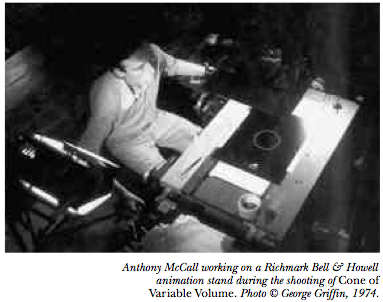User:Lbattich/Review of Anthony McCall at EYE
Review of Anthony McCall's exhibition at EYE, Amsterdam
The visitor to Anthony McCall's exhibition at EYE, Amsterdam, may be struck by the close continuity of his work from Line Describing a Cone (1973) to his most recent work on the last ten years, despite the long hiatus in between. Line Describing a Cone and Long Film for Four Projectors (1974) where made and conceived as 16mm film projections. The recent films, on the other hand, not only employ digital projection, but also their mode of production is digital: the moving images are generated by a computer algorithm. Whereas these could be seen as no more than technical considerations, they have a profound impact on how the work is made and how it may be experienced. One important difference, in terms of aesthetic experience, it is the absence in the digital work of the drone-like sound of the 16mm projector. This sound has been influential for other of McCall works, such as the sound installation Traveling Wave (1972/2013). By working with algorithms to produce images, his recent works seem closer to the instruction-based practice that has been central to his strategy as an artist. On this note, Sol LeWitt's "Paragraphs on Conceptual Art" might be elucidating: "When an artist uses a conceptual form of art, it means that all of the planning and decisions are made beforehand and the execution is a perfunctory affair. The idea becomes a machine that makes the art."[1] The recent digital works do away with the "perfunctory affair" of animating frame by frame for a 16mm film strip.
However, whatever the means utilized to create the imagery on the films, for McCall the importance lies in the solid shapes created by the projected light. Thus, even while creating film animations in the traditional manner for 16mm film, McCall remarks that "when I made it I was really thinking about what was being created in the space between the wall and the projector."[2] I am interested in this interplay between simple yet rigid instructions, and the experiential result created in space. The film imagery is created according to a particular logical scheme. In the recent digital works, these schemes include the interaction of shapes such as an ellipsis, a wave and a floating line. Their interaction is rigidly decided, usually by including a "wipe" motion that discloses the different shapes. And yet, for all the schematic logic dictating what happens in the screen, the sculptural shapes created in space can seem, in the artist words, "quite demented".[3]
McCall's solid-light works question the specificity of artistic mediums, as they engage with film, sculpture, time-based installation, performance and drawing. As he related in during the artist’s talk held at the EYE center, the root for his solid-light work lie in his desire to produce a film that would exists only at the moment of its projection, almost in the manner of an artistic performance in real time (as opposed to the documentation of a performance taking the status of an artwork on its own). Rather than exploring the differences between artistic mediums, McCall seem to me to disregard such traditionsl divisions in favour of creating a particular experience that would engage and immerse the audience.

